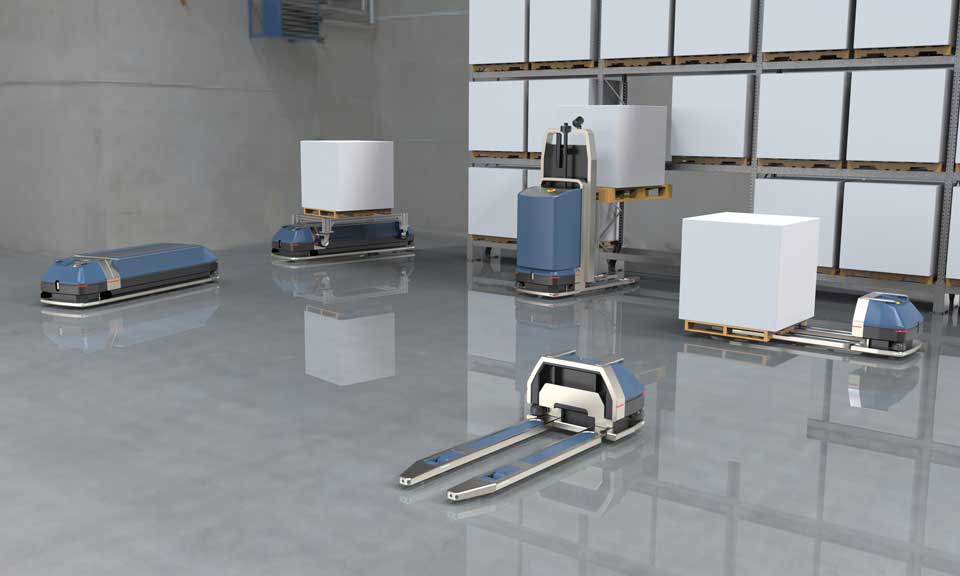MODULARES AGV KONZEPT
Designstudie
Automatisierung und Konnektivität in industriellen Produktions- und Warenwirtschaftsprozessen erfordern umfangreiche Investitionen in die Konzeption und Umsetzung von Logistik und Infrastruktur bzw. die Umrüstung großer Teile bestehender Fahrzeugflotten. Wir wissen, dass dies eine hohe Einstiegsschwelle für viele kleinere Unternehmen ist, die AGVs oder AMRs einsetzen.
Könnte man mit einem modularen Konzept die Einstiegsschwelle senken? Wir haben uns entschieden, mit einem Hubwagen als Basismodul zu beginnen. Der folgende Schritt wäre, den Plattformwagen und einen leichten Gabelstapler als kombinierbare Funktionsmodule anzubieten.
Um die Investitionskosten zu senken, soll nur das Basismodul über ein angetriebenes, lenkbares Fahrwerk und den Hauptsteuerungsprozessor sowie eine leistungsfähige Batterie verfügen. Die Räder an der Gabel sind lenkbar, aber nicht angetrieben.
Die beiden Funktionsmodule haben komplementäre Steuerprozessoren, Batterien zur Unterstützung ihrer eigenen Funktionen und kein angetriebenes Fahrgestell. Die Kopplung und Entkopplung von Basis- und Funktionsmodulen kann je nach anstehender Lade- und Transportaufgabe erfolgen.
Auch die Bedienung war ein zentraler Aspekt bei der Entwicklung. Ein 360°-Umgebungserfassungsbereich ohne tote Winkel und Abstandssensoren in den Gabelspitzen sorgen für ein hohes Maß an Sicherheit. Darüber hinaus ist eine differenzierte Bewegungs- und Statusanzeige der Fahrzeuge in diesem Zusammenhang sehr wichtig. Daher die vielen LED-Anzeigen in alle Richtungen.
Für das Erscheinungsbild der Fahrzeuge haben wir uns bewusst für ein sehr solides und rationales Design entschieden, das Vertrauen erwecken soll und die Struktur der Fahrzeuge auf den ersten Blick verständlich darstellen kann.

MODULAR AGV CONCEPT
Inhouse design study
Automation and connectivity in industrial production and goods management processes demand comprehensive investments in concepts and implementation of logistics and infrastructure; or for conversion of large parts of existing transport vehicle fleets.
We understand that this is an high entry threshold for many smaller companies that employ AGVs or AMRs.
Could we lower the entry threshold here with our modular design concept? We decided to start out with a pallet truck as the basic module. Next step is to offer the platform truck and a light forklift truck as combinable function modules.
To reduce investment costs, only the basic module should have a powered, steerable chassis and the main control processor, as well as a powerful battery. The wheels on the fork are steerable but not powered.
The two function modules have complementary control processors, batteries to support their own functions and no powered chassis. The coupling and decoupling of basic and functional modules can be done according to the upcoming loading and transport task.
Operation issues were also central aspect of the design. 360° environment scanning area without blind spots and distance sensors in the fork tips provide good safety features. Beyond that differentiated movement and status indication of the vehicles are very important in this context. Hence the many LED indicators in all directions.
For the appearance of the vehicles, we have deliberately chosen a very solid and rational design that should inspire confidence and be able to depict the structure of the vehicles in a way that can be understood at first glance.






